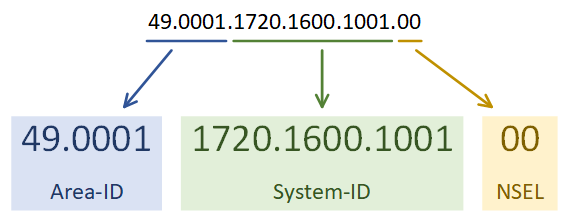NET Value
A Network Entity Title, or ‘NET’, is an address that identifies the router. It consists of the router’s system ID, and the area address. A NET is a type of NSAP address.
Each router’s NET is unique. They can be anywhere from 8 to 20 bytes long, but are often only 10 bytes.
An example of a NET is 49.0001.1720.1600.1001.00. As shown in the example below, this represents the Area-ID, System-ID, and NSEL values.

The address is a series of HEX values, separated by dots. The Area-ID is variable in length, but must be at least one byte. It is often a three-byte value. The first byte (49 in this example) is the AFI, or Address Family Identifier. This is often set to 49 for IS-IS, which is the OSI value for private addressing. 0001 in this example refers to area 1.
The System-ID needs to be unique within the area, but may overlap in different areas. Combining it with the Area-ID makes the entire address unique. In Cisco’s IS-IS implementation, the System-ID is 6 bytes.
The NSEL is the N-Selector. This has a special meaning in the OSI stack, but for IS-IS this will always be set to zero.

No comments:
Post a Comment